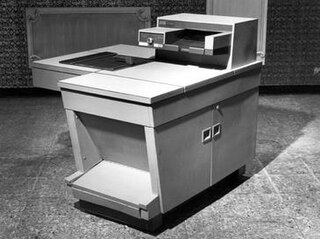
Xerox Corporation is an American global corporation that sells print and digital document and services in more than 160 countries. Xerox is headquartered in Norwalk, Connecticut, though its largest population of employees is based around Rochester, New York, the area in which the company was founded. The company purchased Affiliated Computer Services for $6.4 billion in early 2010. As a large developed company, it is consistently placed in the list of Fortune 500 companies.

Ovie Clark Fisher was an attorney and author who served for 32 years as US Representative for Texas's 21st congressional district.

The Xerox 914 was the first successful commercial plain paper copier which in 1959 revolutionized the document-copying industry. The culmination of inventor Chester Carlson's work on the xerographic process, the 914 was fast and economical. The copier was introduced to the public on September 16, 1959, in a demonstration at the Sherry-Netherland Hotel in New York, shown on live television.
Dr. Gene A Mueller is an American historian and author. Mueller was born in Milwaukee, Wisconsin and is considered an expert in two areas of history, American Nez Perce Indian Culture and 20th Century Europe, specifically Hitler's generals. He has published several books. He has taught at the Lewis-Clark State College in Lewiston, Idaho, Henderson State University at Arkadelphia, Arkansas, and Texas A&M University–Texarkana.
Joseph Chamberlain Wilson was the founder of the Xerox Corporation, a graduate of the University of Rochester and a member of the Delta Kappa Epsilon fraternity. He helped to develop xerography pioneered by Chester Carlson.
John Nelson Warfield was an American systems scientist, who was professor and director of the Institute for Advanced Study in the Integrative Sciences (IASIS) at George Mason University, and president of the Systems, Man, and Cybernetics Society.
Mary Esther Harding (1888–1971) was a British-American Jungian analyst who was the first significant Jungian psychoanalyst in the United States.
William Barlow was an Anglican priest and courtier during the reign of James I of England. He served as Bishop of Rochester in 1605 and Bishop of Lincoln in the Church of England from 1608 until his death. He had also served the church as Rector of St Dunstan's, Stepney in Middlesex and of Orpington, in Kent. He was also Dean of Chester Cathedral, and secured prebends in Chiswick and Westminster.
Wee Pals is an American syndicated comic strip about a diverse group of children, created and produced by Morrie Turner. It was the first comic strip syndicated in the United States to have a cast of diverse ethnicity, dubbed the "Rainbow Gang".
The Photostat machine, or Photostat, was an early projection photocopier created in the decade of the 1900s by the Commercial Camera Company, which became the Photostat Corporation. The "Photostat" name, which was originally a trademark of the company, became genericized, and was often used to refer to similar machines produced by the Rectigraph Company.
Gordon Battelle was the founder of Battelle Memorial Institute, a non-profit independent research and development organization.

Kamil Václav Zvelebil was a distinguished Czech scholar in Indian literature and linguistics, notably Tamil, Sanskrit, Dravidian linguistics and literature and philology.
Robert Bruce Lindsay was an American physicist and physics professor, known for his prolific authorship of physics books in acoustics, and historical and philosophical analyses of physics.

A photocopier is a machine that makes copies of documents and other visual images onto paper or plastic film quickly and cheaply. Most modern photocopiers use a technology called xerography, a dry process that uses electrostatic charges on a light-sensitive photoreceptor to first attract and then transfer toner particles onto paper in the form of an image. Heat, pressure or a combination of both is then used to fuse the toner onto the paper. Copiers can also use other technologies such as ink jet, but xerography is standard for office copying. Earlier versions included the Gestetner stencil duplicator, invented by David Gestetner in 1881.
Clive W. Kilmister was a British Mathematician who specialised in the mathematical foundations of Physics, especially Quantum Mechanics and Relativity and published widely in these fields. He was one of the discoverers of the Combinatorial Hierarchy, along with A. F. Parker-Rhodes, E. W. Bastin, and J.C.Amson. He was strongly influenced by astrophysicist Arthur Eddington and was well known for his elaboration and elucidation of Eddington's Fundamental theory.
John H. Dessauer, also known as Hans Dessauer, was a German-American chemical engineer and an innovator in developing xerography. He was instrumental in turning a $7 million company of the 1930s into Xerox, a billion-dollar copier company.
James L. Blount was an American newspaper editor and historian. Blount was editor of the Hamilton Journal-News, the daily newspaper in Hamilton, Ohio and wrote extensively on the history of Hamilton and Butler County, Ohio.





